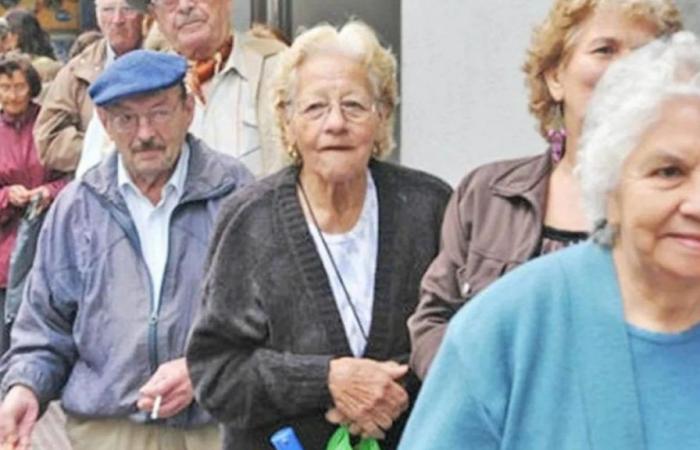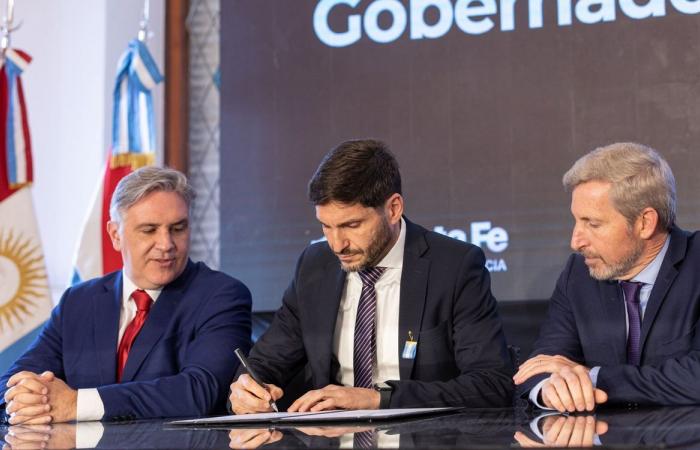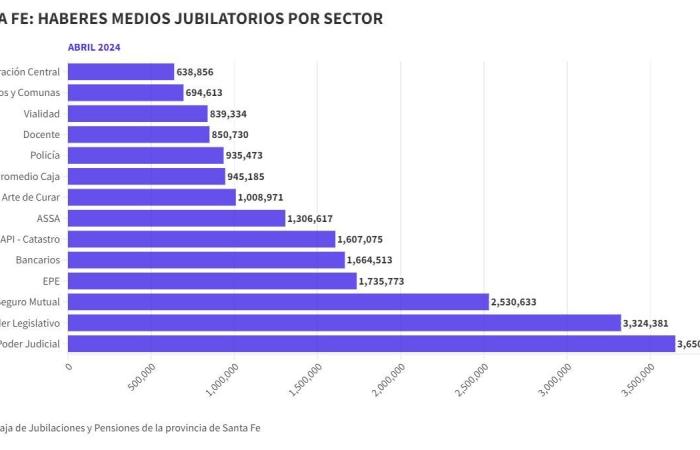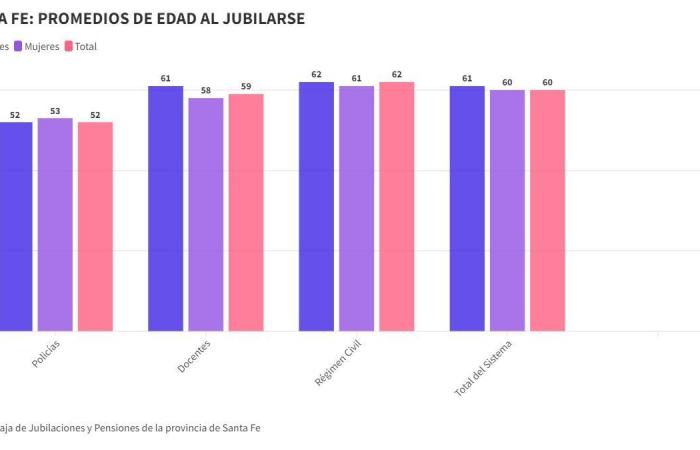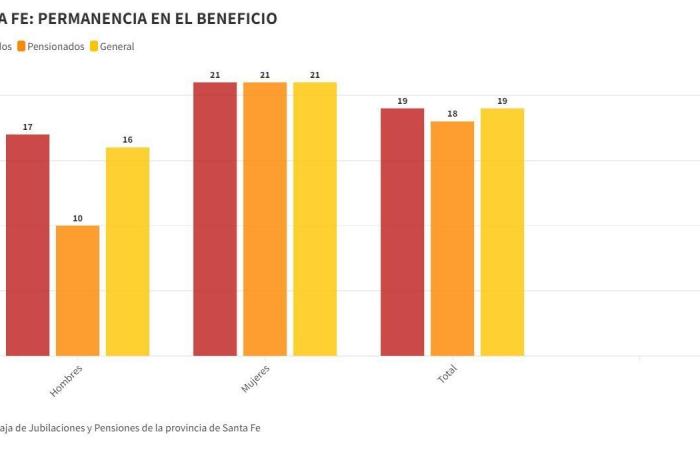Although the debate on the future of the pension system has just begun -from a commission made up of the Executive Branch, deputies, senators and unions that represent public employees-; The political decision has been made and the ruling party has the support of the legislative majorities.
While state unions oppose any change that would imply a loss of rights for future provincial retirees and pensioners, the deficit is growing and the system is only supported by contributions made by the Government through General Revenue.
Among other demands, the unions propose that the State of Santa Fe should “launder” all the income of its workers, to generate greater contributions to the Retirement Fund. However, the government assures that if this were to happen, the deficit would be reduced by just 15%.
Retirements. Commission1.jpg
A commission made up of executive officials, representatives of the legislative branch and public unions of Santa Fe is already working on the reform of the provincial pension system.
The current administration insists that the imbalances make the system unsustainable. Not only because it subsists thanks to contributions from General Revenue funds that could be used for other purposes, but because these funds are generated largely from taxes from private sectors that do not maintain any employment relationship with the provincial State.
“This month’s deficit is going to be close to 40 billion pesos, we are talking about that in one month we could have built 8 schools, 40 kilometers of road or bought 940 patrol cars,” the governor said a few days ago. Maximilian Pullaro.
There are at least two fronts to take into account.
On the one hand, the debt of around 700 billion pesos that the Nation has with Santa Fe, one of the 13 provinces that in the nineties decided not to transfer its Pension Fund.
Pullaro Llaryora Frigerio Central Region 1.jpeg
The governors of Santa Fe, Córdoba and Entre Ríos, demand in a coordinated manner before the Nation the funds owed to compensate for pension deficits.
For another, the breakdown of the balance between the contributions made month after month by the 208,000 active workers of the Santa Fe State, and what the 102,000 retirees and pensioners who were once provincial agents receive.
Both factors go hand in hand.
Santa Fe maintains its claim for the Nation’s accumulated debt. So much so that last year the Province took its case to court and, in the last hours, Maximiliano Pullaro; the governor of Córdoba, Martin Llaryora; and that of Entre Ríos, Rogelio Frigeriosigned a declaration to jointly and consensually address with the National State the problem of financing the deficits of the pension systems of the three provinces of the Central Region.
However, while the claims are repeated and a response is awaited that appears uncertain, distant and even improbable – in 2023 the Nation covered the debt of 2019 and the government of Javier Milei deleted all transfers-; In June, the State of Santa Fe paid retirements and pensions for approximately 100 billion pesos, with a system that barely collected about 70,000 million.
Santa Fe Retirement Fund: 14 subsectors with different degrees of deficit
In the Santa Fe retirement system there are 14 subsectors: security, teachers, Central Administration, API/Cadastre, Judicial Branch, Roads, Healing Arts, Graphics, Pension Fund, Dipos, Legislative Branch, banking, EPE, Municipalities and Communes.
In all cases, workers contribute 14.5% of their salaries to support the Provincial Retirement and Pension Fund, while the State contributes 17.2%.
Each of these sectors reflects different situations, but in general they are all in deficit. Municipalities and Communes and the Central Administration appear to be the most balanced. However, in some cases the deficit between the contributions and the pensions paid ranges from 50%.
While the general national retirement and pension regime that depends on Ansés has a limit of 1,392,450 pesos in June 2024 -no one charges more than that-; In Santa Fe the maximum retirement exceeds 9 million pesossince it is equal to 80% of the salary of the president of the Supreme Court of Justice of the Province, with 30 years of seniority.
Average retirement assets by sector April – 2024.jpeg
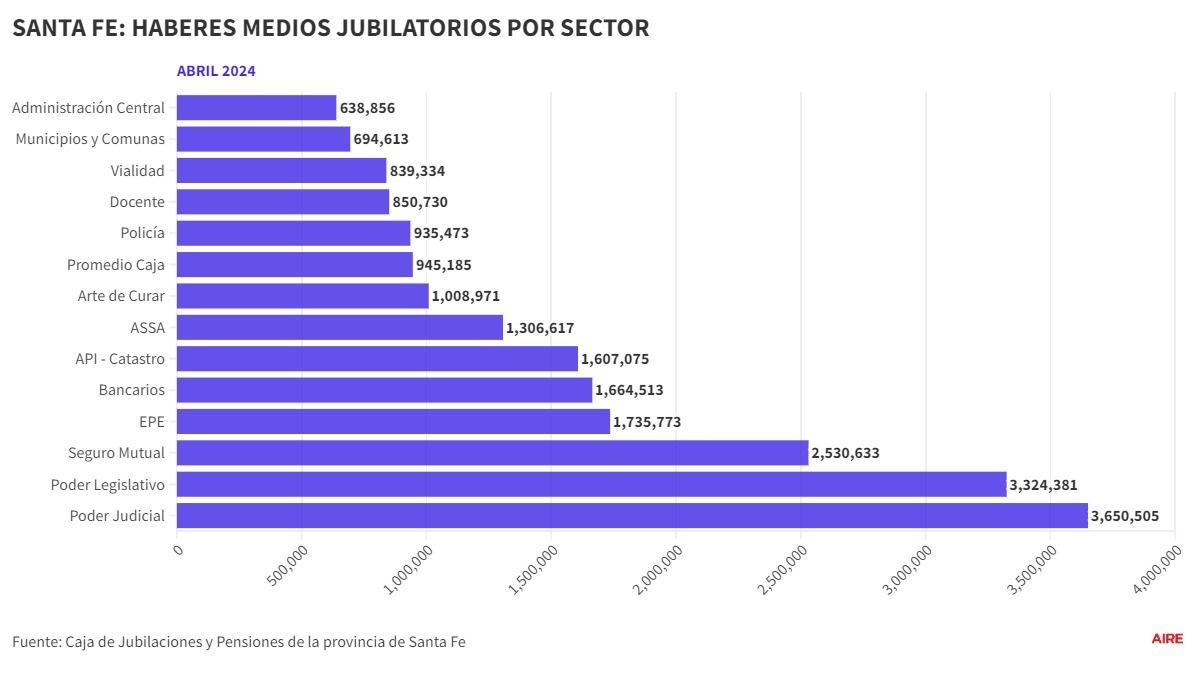
The 4,598 active workers of the Santa Fe Judicial Branch contribute around 4.5 billion pesos per month; but the payment to the 2,900 retirees and pensioners of the sector implies an expenditure of around 8.7 billion.
The case of Justice reflects some of the main imbalances.
Under a “law of connection”, any salary increase in the Judiciary at the national level is transferred to the agents of the Judiciary of Santa Fe.
However, While the active workers of the national Justice Department contribute 18% of their salaries to their future retirements, the workers of the Santa Fe Judicial Branch only contribute 14.5% of their salaries.as well as teachers, the central administration, the police and each of the subsectors of the Santa Fe retirement system.
The average pension of the Judicial Branch in the province of Santa Fe is 3,650,505 pesos per month, closely followed by the Legislative Branch – it has 2,039 contributors and 950 beneficiaries -, with an average of 3,324,381 million.
In the case of teachers, pension payments in April amounted to around 32 billion pesos per month, but contributions barely exceeded 21 billion pesos, so the deficit hovers around 35%.
The subsector corresponding to the EPE – around 4,000 contributors to cover 3,700 retirements and pensions – has a deficit of 48% between what the active ones pay in taxes and what the passive ones receive.
Retirees with an average of 60 years
The ideal relationship for a retirement system to be sustained is that there are between 3.5 and 4 contributors for each retiree or pensioner. Although this balance is not achieved in any regime -especially due to increases in life expectancy-, this year the ratio in the province of Santa Fe is 2.7 assets for every liability.
But that is not all. The average retirement age for Santa Fe state employees is just 60 years old, and in some subsectors the retirement ages are even lower.
Male teachers retire at 60, while women retire at 57; male police officers retire at 55 and women at 52; while the rest of the state men retire at 65 and women at 60.
AVERAGE AGE AT RETIREMENT.jpg

However, The average retirement ages are lower, because in all cases there is the possibility of advancing retirement one year, for every two years worked after 30 years of service.
Just as an example: a male teacher with 36 years of service can retire at 57; while a female teacher with the same amount of service can retire at 54.
If that person were to live to be 90, they would have spent the same amount of time in their life working – 36 years – as they would have as a retiree in the province of Santa Fe.
AVERAGE AGE AT RETIREMENT.jpg

For its part, a central administration employee with 34 years of service can retire at 63 if he is a man or at 58 if he is a woman.
The average retirement age of public agents in Santa Fe is as follows: police officers, 52 years; teachers, 59 years old; rest of the system, 62 years.
In the case of teachers, only 60% retire when they reach the age to do so; in the central administration, 62%; in the EPE, barely 16%; and in the rest of the sectors, 51%.
Women represent almost 70% of retirees and pensioners in Santa Fe
Another important fact is that 69% of the beneficiaries of the Santa Fe Retirement Fund are women.
Official statistics show that women not only retire five years earlier on average, but also live five years longer than men.
On average, retired or pensioned men in Santa Fe die at age 77, with a permanence of 16 years within the system; while women live until age 81, with an average permanence of 21 years in the retirement and pension system.
PERMANENCE IN THE BENEFIT.jpg
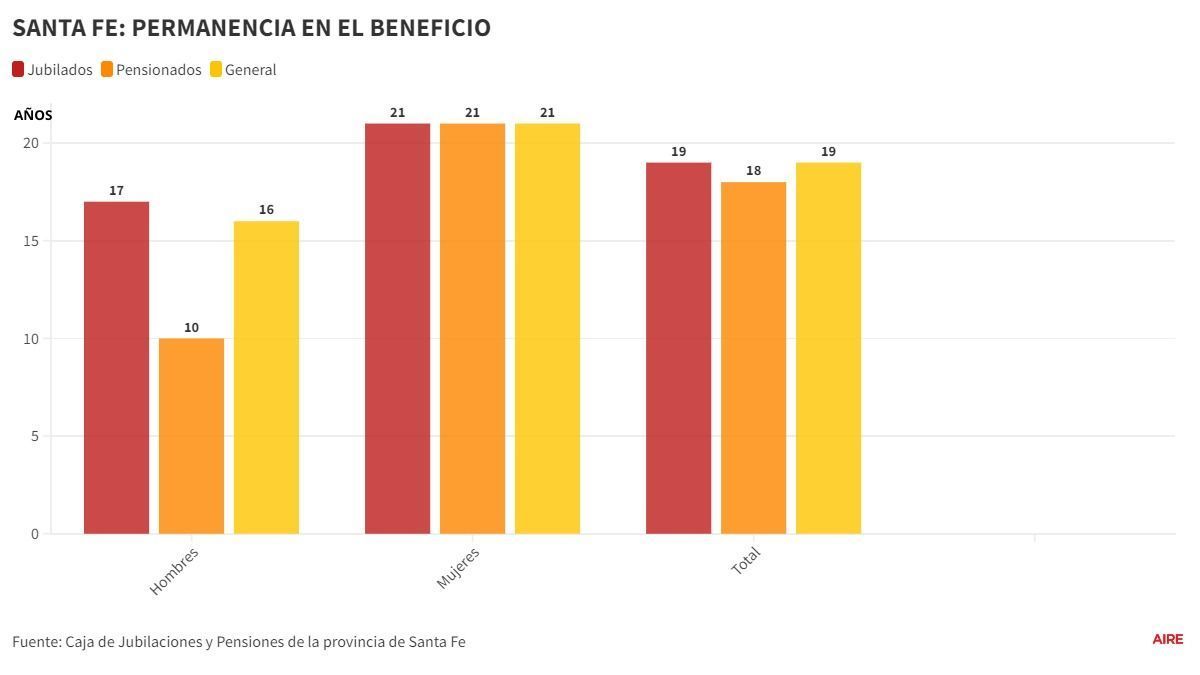
For these reasons, it is not ruled out that a future reform of the system will advance the progressive equalization of the retirement ages of men and women.
The commission created to generate a report on the general situation of the Province’s retirement system is moving quickly. In a matter of days, the voices of teachers, judicial employees and magistrates were heard.
At the moment the details of the reforms of the retirement system that the Executive Branch has in the pipeline have not been revealed and the final results of these rounds of consultations are awaited.
Anyway, There are only three alternatives to reduce the deficit: finding mechanisms that allow for a reduction in the amounts allocated to the payment of retirement and pensions in the future, increasing the contributions made by active state employees, or advancing both objectives at the same time.
While uncertainty about the future of the Pension Fund is raised for all these reasons, there are at least three certainties:
- 1. The Santa Fe Retirement and Pension Fund will continue to depend on the Province.
- 2. A distribution system will be maintained.
- 3. The rights acquired by retirees and pensioners of Santa Fe will not be modified, but the political decision of the Executive – which has legislative majorities – has been made and changes to move towards the balance of the Fund seem inevitable.

